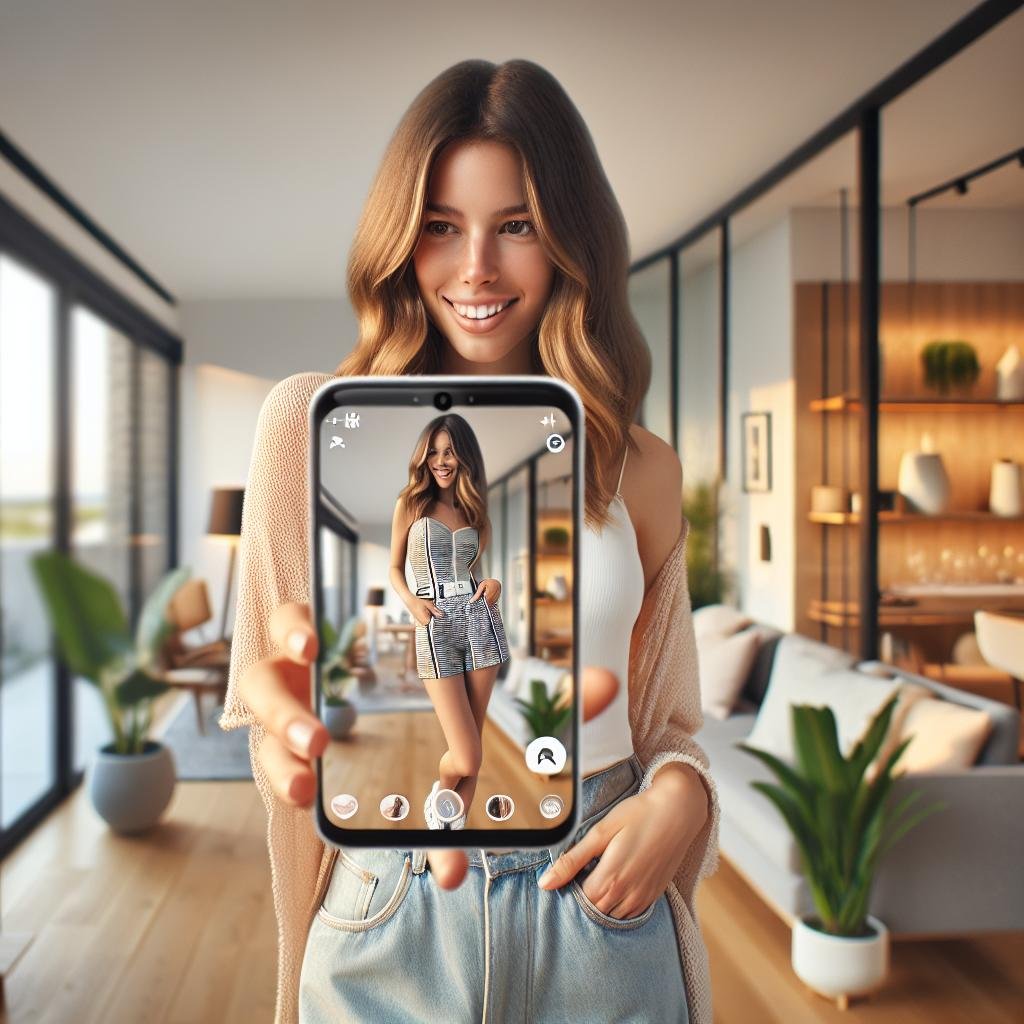
AI Clothes Try-On with Doppl: Ultimate Preview Guide
Google has unveiled Doppl, an innovative AI tool that lets shoppers see how clothes will look on them through realistic video previews. This virtual fitting room technology creates personalized try-on videos showing how garments move and fit your body without requiring you to upload photos or videos of yourself. Available now as a beta feature in Google Search, Doppl aims to reduce return rates for online clothing purchases by giving shoppers confidence in how items will actually look on them.
What is Doppl and How Does It Work?
Doppl represents Google’s latest advancement in AI shopping tools, designed to solve one of online clothing retail’s biggest challenges – visualizing fit. When browsing participating retailers in Google Search, you’ll see a “Try it on” button beside eligible clothing items. After entering your height, weight, and body shape, Doppl generates a custom avatar that mimics your proportions.
Unlike static image try-on tools, Doppl creates short videos showing the clothing in motion – a more realistic representation of how garments drape, fold, and move with the body. The technology works without requiring users to share personal photos or videos, addressing privacy concerns that often accompany virtual fitting tools.
Google has partnered with several retailers for the initial rollout, including FRAME, Everlane, and Anthropologie. The company plans to expand these partnerships as the feature progresses beyond its current beta status.
The Technology Behind Doppl
Doppl leverages sophisticated computer vision and generative AI to create its realistic try-on videos. The system analyzes the garment’s structure, fabric properties, and how it typically moves on human bodies. It then applies this understanding to generate a personalized preview based on your provided measurements.
According to Google’s official announcement, the AI models have been trained on diverse body types to ensure accurate representation across different shapes and sizes. This addresses a common criticism of virtual fitting technologies that often work well only for standard model proportions.
The video format is particularly significant because it demonstrates how clothes behave during movement – something static images simply can’t convey. This dynamic representation helps shoppers understand details like:
- How the fabric drapes on your specific body type
- Whether the garment will be tight or loose in certain areas
- How the clothing moves when walking or turning
- The actual fit compared to product photos featuring models
How to Access and Use Doppl
Currently, Doppl is available as a beta feature in Google Search for US users. The process to use the tool is straightforward:
- Search for clothing items from participating retailers in Google Search
- Look for the “Try it on” button beside eligible products
- Enter your height, weight, and select a body shape that best matches yours
- View the generated video showing how the garment would look on your body type
- Compare different sizes or styles using the same avatar
The tool doesn’t require downloading a separate app or creating an account, making it accessible directly through the search interface. While currently limited to certain retailers and clothing types, Google has indicated plans for expansion to more brands and product categories.
Privacy Considerations
A standout feature of Doppl is its privacy-forward approach. Unlike some competing virtual try-on technologies that require users to upload photos or create detailed body scans, Doppl works with basic measurements and body type selections.
Google has clarified that the information provided for creating avatars isn’t stored or used for advertising purposes. The avatars themselves are generated on-demand and not permanently associated with user accounts. This design addresses growing consumer concerns about biometric data collection and personal image usage in digital shopping experiences.
Benefits for Shoppers and Retailers
The introduction of Doppl offers significant advantages for both consumers and clothing brands:
For Shoppers:
- Reduced uncertainty about how clothes will fit and look
- Fewer returns due to fit issues or style disappointments
- Time saved by avoiding physical try-ons or return processes
- Ability to “try” more styles quickly than would be possible in stores
- Privacy-preserving way to visualize clothes on your body type
For Retailers:
- Potential reduction in return rates, which currently average 30-40% for online clothing purchases
- Increased shopper confidence leading to higher conversion rates
- Reduced environmental impact from fewer shipping-related emissions
- Valuable data on customer fit preferences (aggregated and anonymized)
- Competitive advantage through enhanced shopping experiences
Industry analysts predict that virtual try-on technology could significantly impact online clothing retail economics. With clothing returns costing retailers an estimated $100 billion annually in the US alone, tools like Doppl that improve purchase confidence address a critical industry pain point.
Real-World Example
Consider Sarah, a busy professional who typically avoids buying clothes online due to inconsistent sizing across brands. Last month, she needed a dress for an upcoming event but lacked time for in-store shopping. Using Google Search, she discovered a dress from Anthropologie with the Doppl “Try it on” option.
After entering her measurements, Sarah viewed a video showing how the dress would move and fit on someone with her body type. She noticed the waist appeared slightly tight and ordered one size up. When the dress arrived, it fit perfectly—matching what she’d seen in the Doppl preview. This experience changed her online shopping habits, as she now feels more confident making purchases when Doppl previews are available.
“Before using this tool, at least half my online clothing orders would end up being returned,” Sarah explained. “The video preview showed me exactly how the fabric would drape on my body shape, something static images never conveyed accurately.”
How Doppl Compares to Other Virtual Try-On Solutions
Doppl enters a growing field of virtual fitting technologies, but distinguishes itself in several ways:
| Feature | Doppl (Google) | Typical Photo-Based Try-On | 3D Body Scanning Solutions |
|---|---|---|---|
| Format | Video previews | Static images | 3D models |
| Personal data required | Basic measurements only | User photos | Detailed body scans |
| Shows movement | Yes | No | Sometimes |
| Accessibility | Direct in search results | Usually requires app download | Specialized equipment often needed |
Other major players in this space include Amazon’s Virtual Try-On and several retailer-specific solutions. However, most competitors focus on static image overlays rather than dynamic video representations.
Limitations and Future Development
While promising, Doppl does have several current limitations:
- Limited availability to US users in Google Search beta
- Partnership with only a handful of retailers initially
- Focus primarily on women’s clothing in the beta phase
- Simplified body type options that may not capture all body variations
- Cannot account for unique aspects of individual posture or movement patterns
Google has outlined plans to address these limitations in future updates. The company is working to expand retailer partnerships, add more detailed body customization options, and extend the technology to additional clothing categories including menswear.
Industry experts anticipate that as the technology matures, it could incorporate more sophisticated elements such as fabric texture simulation and personalized style recommendations based on fit preferences.
The Bigger Picture: AI’s Growing Role in Retail
Doppl represents just one aspect of AI’s expanding influence in the retail sector. Virtual try-on technology is part of a broader trend toward digitizing the shopping experience, with innovations appearing across the customer journey.
According to retail technology research firm Coresight, investment in AI shopping tools has increased by over 40% since 2020, with virtual fitting room technologies representing one of the fastest-growing segments. This acceleration reflects both consumer demand for better online shopping experiences and retailer recognition of the financial benefits of reducing returns.
As these technologies mature, we can expect further integration between virtual try-on tools and other aspects of the shopping experience, such as:
- Personalized size recommendations based on try-on data
- Style suggestions that account for both preferences and fit
- Integration with augmented reality for in-home visualization
- Adaptive pricing that reflects return probability
Is Doppl Right for You?
Doppl offers clear benefits for shoppers who:
- Frequently purchase clothes online
- Have difficulty visualizing how garments will look based on product photos
- Experience frustration with inconsistent sizing across brands
- Value privacy when using digital shopping tools
- Want to reduce time spent on returns
The tool may be less helpful for those who prefer in-store shopping experiences or have very specific fit requirements that simplified body type options can’t fully address. However, as the technology evolves, its usefulness will likely expand to serve more diverse shopping needs.
Getting Started with Doppl
If you’re interested in trying Doppl for yourself, the process is simple:
- Ensure you’re using Google Search in the US (where the beta is currently available)
- Search for clothing from partner retailers like FRAME, Everlane, or Anthropologie
- Look for the “Try it on” button in search results for eligible items
- Follow the prompts to enter your measurements and body type
- View and interact with the generated video preview
No special accounts or permissions are needed beyond normal Google Search access. As Google expands the feature to more retailers and regions, availability will increase accordingly.
Conclusion
Google’s Doppl represents a significant step forward in solving the persistent challenge of visualizing clothing fit in online shopping. By generating realistic video previews based on simple body measurements, the technology offers a privacy-conscious solution that could reduce return rates while improving shopping confidence.
While currently limited in scope as a beta feature, Doppl points toward a future where AI increasingly bridges the gap between digital convenience and physical reality in retail experiences. As the technology matures and expands to more retailers and clothing categories, it has the potential to fundamentally change how we shop for clothes online.
Have you tried Doppl or similar virtual try-on technologies? We’d love to hear about your experience and whether these tools influenced your purchasing decisions.
